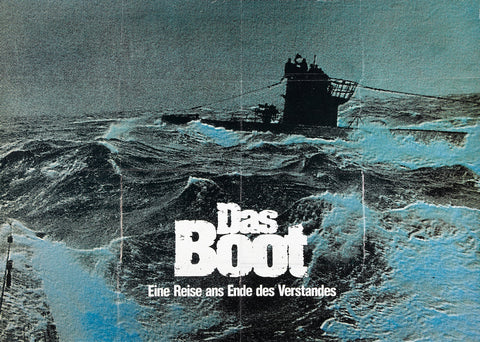The wide expanse of the ocean… the claustrophobic confines of a submarine… the endless fear of torpedo attack… the perfect subject matter for cinematic gold, but whilst the army is regularly the focus of overly-dramatic Oscar-fodder, when it comes to the silver screen, the navy is often left out at sea.
That said, there have been a few classic maritime movies made over the years—you’ve just got to dive a little deeper to find them. With this season’s Authentic and Lybro collections paying homage to the sailors involved in the Arctic Convoys of WW2, here are a few slices of seafaring cinema worth hunting down...
Western Approaches - 1944
Western Approaches is a potent piece of docu-fiction which tells the tale of a crew of British merchant seamen stranded at sea after their ship is attacked by a German U-Boat. Using real sailors instead of actors, this film sits somewhere between fact and fiction—and although the dialogue is a little clunky, it offers a genuine look at the people who were actually involved in the convoys. The film also stands out as it was shot on colour film—a rarity in the 1940s—giving a technicolour glimpse at the clothing worn by the merchant navy during WW2.

The Enemy Below - 1957
Whilst British films like Western Approaches, The Cruel Sea and We Dive at Dawn were crammed full of sailors huddled in duffle coats and roll-necks knits shivering in the North Sea, American films like The Enemy Below and Run Silent, Run Deep replaced the thick woollen-wares with khaki chinos and white t-shirts as US Navy sailors sweated it out in the South Atlantic and the Pacific.
A bit easier to watch when compared to some war films of the era (helped by the rich colour film and a fine appearance from the great Robert Mitchum), The Enemy Below follows the American warship, the USS Haynes, as it attempts to intercept a German U-Boat. This might sound like typical Hollywood fare, but by also showing the plight of the German captain and his crew underwater, the film marks a strong departure from the black and white, good vs evil propaganda of earlier war films.

The Sand Pebbles - 1966
This is one of those long, relatively slow films that you might find whilst surfing through the lesser-seen television channels on a rainy Sunday afternoon. A classic slice of 1960s cinema, it stars Steve McQueen as a rebellious US Navy machinist’s mate on a gunboat on the Yangtze River in the 1920s, and although it depicted the early days of the Chinese Republic, the film was taken by many to be a sly critique of the USA’s involvement in Vietnam.
Often regarded as one of McQueen’s finest performances, The Sand Pebbles also features some of his best outfits—from the well-worn chambray work-shirts of the engine room scenes to the navy melton-wool pea-coat he wears during trips on dry land.

The Last Detail - 1973
A navy film set firmly on dry land, The Last Detail is the story of two bored sailors (played by Jack Nicholson and Otis Young) escorting a young seaman to ‘the brig’ (that’s navy slang for military prison) after he was caught trying to nab $40 from a charity collection plate. Directed by the same chap who did Harold and Maude, this is a prime slab of ‘New Hollywood’, which treads similar freewheelin’ territory as Midnight Cowboy and Five Easy Pieces. There are no expensive battle scenes or exotic locations here, and instead you’re treated to a few cold days meandering from Virginia to New England as the two navy lifers try to show their hapless ward a good time before he’s locked up.
As with The Sand Pebbles, there’s some cracking navy gear on display in this one, with the upturned collars of the standard-issue pea coats perfectly suited to the harsh East Coast winter.

Das Boot - 1981
And finally, we’ve got Das Boot—over two hours of fraught tension from the cramped confines of a German U-Boat.
Based on the accounts of war correspondent Lothar-Günther Buchheim, the film features a level of detail rarely seen on screen. Not only was the mock-up U-Boat interior used in the film an exact replica of the original—right down to the screws—but during the making of the film the cast were forbidden from going out in the daytime to help create the pale look of a sunlight-starved submarine crew. All this work wasn’t for nothing, and nearly 40 years after it was made, Das Boot is still regarded as one of the finest war films ever made.
